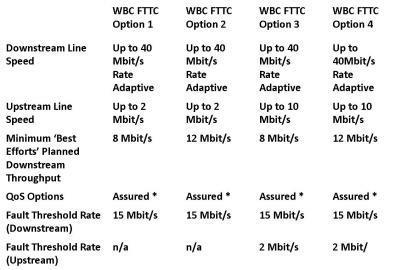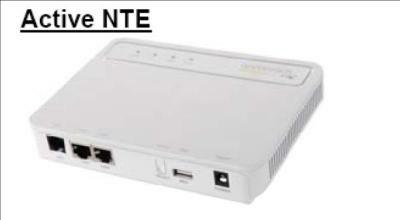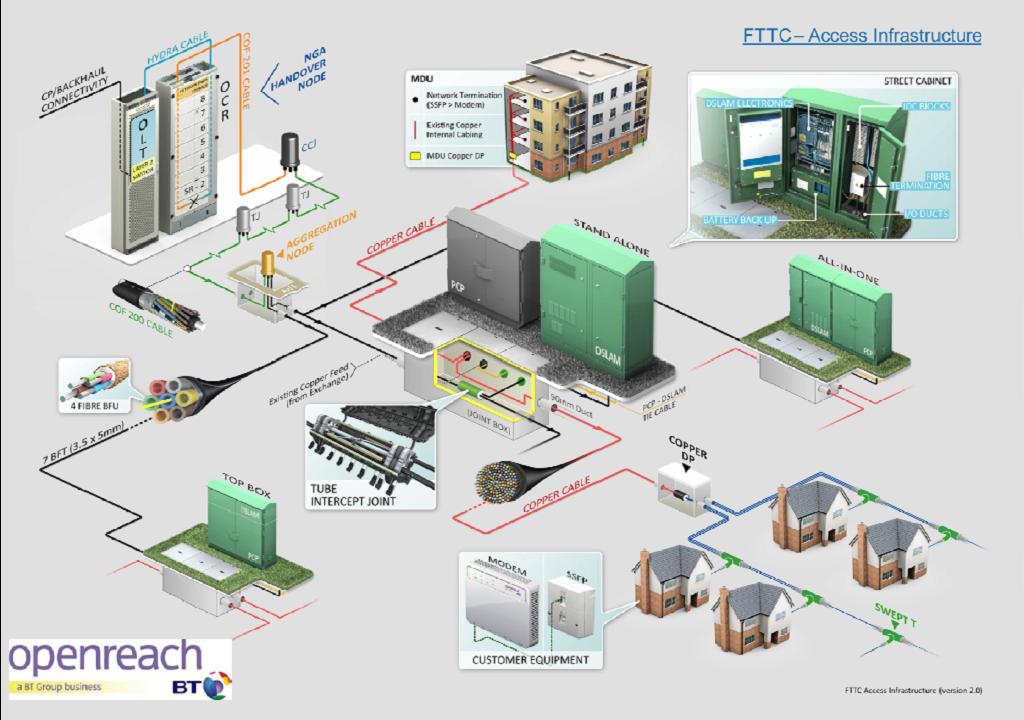Readers who are somewhat unclear on FTTC broadband soon won’t be. Read on.
FTTC broadband exchange rollout posts have attracted a huge amount of interest on this blog. More so in fact than any other subject I have posted on. There is clearly a demand out there for the faster speeds.
There isn’t that much info out there on what the proposition actually is so I am happy to remedy this. The following spiel has been pinched from the BT Wholesale FTTC Handbook (thanks to BT for letting me do this) . This is normally only provided to ISPs who are reselling the technology/solution.
As is the nature of these things I have had to simplify the wording but if you see some complex technospeak it is probable left over from the original text. I’m afraid there is no getting away from the acronyms. The diags are BT (Wholesale & Openreach) originals.
FTTC Intro
Fibre To The Cabinet (FTTC) utilises BT’s 21st Century Network. If an ISP already offers ADSL2+ services based on BT’s 21st Century Network then it is relatively easy for them to extend this to also offering FTTC. They use the same eCo Plus provisioning system for both. For the ISP FTTC broadband is just another ordering option in a drop down box.
FTTC, whilst using the same network from the exchange does have significant differences when compared with ADSL2+ not least of those being faster speeds.
FTTC broadband does not, at launch, have the same geographic coverage as ADSL2+. This is because the roll out to cabinets has only just started and will take some time to reach the same market penetration. This also assumes BT will make the investment which is of course based on a business case for each exchange.
FTTC – General Overview
The BT 21st Century Network (known in this case as Wholesale Broadband Connect or WBC) provides Broadband services from the End User to one of 20 WBC interconnect points around the UK. ISPs, like Timico, connect to BT’s 21st Century Network at these interconnect points.
FTTC uses the same WBC infrastructure but offers an End User Access based on VDSL 2 technology (rather than ADSL 1 and ADSL 2+ on WBC). This End User Access provides a higher line rate of up to 40Mbit/s downstream and optionally up to 10Mbit/s upstream.
The main difference between the FTTC service and ADSL2+ Service is that the DSLAM (Digital Subscriber Line Access Module) is situated in an exchange building for ADSL2+ but for FTTC the DSLAM is situated in a cabinet in the street (the “Street DSLAM”). The Street DSLAM is served with a fibre back to the exchange to carry the Broadband signals.
The Street DSLAM is connected to the Street Cabinet using tie pair cables. VDSL 2 is used to carry the Broadband over the copper pair from the Street Cabinet to the End Users’ premises. See diagram 1 below.

Just like standard ADSL a single ISP buys the FTTC connection on the copper pair. This is necessary to ensure that the available bandwidth over FTTC is allocated for delivery of the best broadband speed technically possible to that premises. More than one copper pair connection can be provided to the premises if the end user requires additional FTTC services.
The baseband voice service can be provided by either the same ISP or a different Communications Provider. The baseband voice service runs over the existing copper network using Wholesale Line Rental on the same copper pair as used by FTTC. This replicates the WLR + Single Metallic Path Facility model where FTTC replaces SMPF.
Note SMPF is the basis of the whole Local Loop Unbundling market.

Note also BT does not yet offer voice services over FTTC (as opposed to the baseband voice service running over copper) but there is nothing to stop the ISP doing so.
FTTC Available Line Speeds
FTTC offers the following VDSL2 line rates:
– Up to 40Mbit/s downstream, with up to 2Mbit/s upstream
– Up to 40Mbit/s downstream, with an optional up to 10Mbit/s upstream.
BT guarantees a minimum 15Mbps downstream provided the connection passes certain tests (enhanced Managed Line Characteristics (eMLC)) and provided issues are reported within 28 days.
The actual rates that can be supported on any individual line are influenced by two main factors. Firstly the distance of the copper connection from the End User’s premises to the Street Cabinet and secondly the number of End Users signed-up and using the common cable which will determine cross-talk noise impact. Either of these two factors may result in the End User experiencing a drop in the speed from what was originally achieved.
The table below sets out the initial WBC FTTC End User Access options (ie speed options) for the FTTC Service.

FTTC Installation
The installation must currently be performed by BT Openreach who contact the End User before the booked appointment to discuss the proposed installation and confirm the appointment slot.
The engineer will call the End User on the day of appointment prior to starting work at the Street Cabinet but will not commence work unless the End User has confirmed their or their agent’s availability.
Openreach engineers only fit the Openreach Active Network Termination Equipment and Openreach VDSL modem. ISPs will typically supply their own routers which simply plug into the Ethernet port of the VDSL modem.
At the End User premises there are two aspects to the Openreach installation.
During the installation of the FTTC service the Openreach engineer will fit a Service Specific Front Plate to the existing NTE5. Where no NTE5 exists, Openreach will install an NTE5 within 3 metres of the entrance to the End User premises. Where an external NTE exists Openreach will install an NTE5 with service specific front plate internally immediately adjacent to the external NTE.
A service specific front plate splits the delivery of telephony and DSL signals at the NTE5, delivering each service to a separate port on the socket. This terminates the DSL signal at this point, meaning the signal is not received on any telephone extension sockets that may exist.
A VDSL2 modem will be supplied and connected to the data port of the service specific front plate. This is an active NTE which allows BT to monitor and test the service provided. The active NTE must be within reach of a power supply, and must remain connected to the power and data port of the service specific front plate at all times.

Openreach VDSL2 modem – plugs into the SSFP
This installation does not need ADSL filters. The modem provided may be different to the one in the photo.

The active Ethernet EU port on the VDSL2 Active NTE supports:
- • 10/100Base-Tx with RJ-45 connectivity
- • Auto-negotiation and MDI/MDIX auto-sensing.
- • Data transfer at wire-speed for all packet sizes.
- • Built-in layer-2 switch
Power Supply
The power supply to the VDSL2 Active NTE is a single, low voltage power interface and is and plugs into a standard domestic UK 240V (ac) socket. The power consumption is <9 W.
Openreach will install a line extension of up to 30m at the premises if required although it is worth noting that all installations will be subject to survey. In other words if an engineer turns up and it is physically impossible or too difficult to do the installation all bets are off.
An End User’s service will be subject to its ISP’s own broadband offerings and applicable terms and conditions. So read the small print!
Anyone wanting the service or looking at preregistering their interest can email to [email protected] and I’ll get someone to either sort it or put you on the waiting list for when the exchange is ready (actually when the cabinet is ready!). If you have any questions you can either leave them as comments on this blog post or email to the same address.
Link to more FTTC stuff and exchange availability information here and here.



15 replies on “FTTC Broadband – What Exactly Is It?”
thanks for all that info! wish I had a bigger brain.
It just makes me wonder why they don’t JFDI and go the last few hundred yards with fibre and do the job right?
Have you any suggestions as to why they don’t? As you point out FttC is much better and faster than ADSL or ADSL2 etc but Ftth is the End Game isn’t it? Why install so much kit when it will have to be replaced within a decade, why not go for the full monty? Or is my tiny brain missing something obvious? I was reading an article today that said the maintenance on the old copper infrastructure would cost as much as replacement with fibre would. Or is that fibre spin?
Hypothetical : Consider a typical small service area for BT that might have one (1) fiber tech and nine (9) copper techs. The fiber tech lights up an FttC-type cabinet and moves on to another work order. Then the nine copper techs can upgrade a bunch of sub-megabit customers to fifteen-megabit-plus without incurring a lot of sticker shock.
FttC pro : cost to the customer, staff utilization for BT, time savings all around.
FttC con : not future-proofed, not as fast as FttH.
Basically, this is a quick but not too dirty solution to a sort of chicken-vs.-egg problem. Keep in mind that those bulky FttC cabinets may have enough elbow room in them to support an upgrade to handle fiber switching. So the cabinet roadmap could be – Gen.1 is FttC, Gen.2 is hybrid, Gen.3 is FttH.
What I want to hear is more on the Rutland FttC service switch as well BT’s own FttC roll-outs. Are the customers still happy after several months ? How are the prices ? And yes, I’ve read the posts on the Rutland Telecom site. I want to hear from an independent survey team.
P.S. Hmmm, something seems a little dodgy in the “Best Efforts” (8 or 12 Mbps) versus the FTR (15 Mbps). The FTR implies a working floor of 18.75 Mbps (15 * 5 / 4). A Google search turned up the term MSR (Maximum Stable Rate) eighty percent (80%) of which is the FTR (Fault Threshold Rate). Oi, what a numbers game !
P.P.S. My apologies for the glossary source – I couldn’t find one at Timico.
http://www.zensupport.co.uk/KnowledgeBase/article.aspx?id=10537
Ted, my understanding is as follows:
The 15Mbps FTR is all about setting a minimum level at which a copper line is considered to be fit for FTTC. When you place your order the line is tested to see if it is likely to support this speed and if not you won’t be able to have the service.
Once in service your line should be stable on at least 15Mbps under normal circumstances otherwise a fault can be raised. That doesn’t mean that during periods of heavy congestion on the WBC network that the line speed won’t drop lower than this.
The minimum ‘best efforts’ throughput is about limiting the amount by which the line speed can drop during the most congested periods – either 8Mbps or 12Mbps depending on which option is selected.
Of course none of this matters if your service provider is throttling your bandwidth due to having oversold their capacity. That’s where a company like Timico can make all the difference. Sorry for the plug, yes I do work for them!!
@ amassing – Thanks for the response + the info.
I know that some fiber optic cables that are in service can carry more traffic by upgrading the driver module (laser, sensor, and logic). Is my guess about cabinet contents in my original comment on target ? I don’t expect an official response, but an off-the-record “That possibility exists.” would make the FttC roadmap more palatable to all of us. I’ve done customer-side network support and am aware of the bottleneck caused by the lack of qualified technicians.
Ted
I’ll ask BT if they want to comment. However one take is this: Aside from what the costs of physically delivering the fibre to the home part of the cost issue stems from the bandwidths available.
FTTH = faster = people using it more. FTTC currently has 1Gig to the cabinet. If that cabinet served FTTH then potentially you need to start upgrading your whole backhaul infrastructure to carry more traffic.
I guess multiple 1Gig connections from the cabinet are possible but the cost of upping this to 10Gig is fairly high (4x). You would almost certainly be doing this in every exchange if not every cabinet.
The BT Wholesale business model is very much based on charging ISPs for usage but the jump to everyone using 100Gig might have to be a gradual one – either waiting for costs to come down to accomodate the increased usage or for End Users to get used to paying more for this usage.
Trefor,
I read with interest your article regarding FTTC. How is this to work in practice/ Currently there is widespread competition with ISP’s leasing Datastream and IPStream products. There is also LLU sites with ISP’s providing their own DSLAM’s co-located with BT sites.
In the FTTC model ISP’s will look closely at the business case for a given exchange and in the case of a rural one would more than likely have a monopoly. How is it going to be possible for existing customers to remain with their current ISP’s?
Many thanks
David
Ignore last post answer found. Thanks
@David Harvey – Would be interested in the answers, particularly to the ‘what other ISPs might do’, and how customers might remain with their current ISPs.
My guess is that when FTTC is in place, BT will be required to offer access (some form of switch at the exchange), that would allow for the current LLU services to have traffic passed into their own backhaul. It rather makes the idea of “LLU” the default as there would no longer be the need for another ISP to have a DSLAM at an exchange. Everything would ‘just’ need to be routed to the ISP.
I know an LLU service can offer lower cost per GB of traffic, because they’re not paying BTw rates, but do they have their own fibre, or are they getting some cheaper rate from BT for bulk purchase of say 20% of the total capacity from the exchange?
I think LLU operators source their own connections from the exchange and don’t always use BT – certainly that is the case with us in our 11 exchanges
“Losers” in this new situation would be anyone who would like to use a different ISP (where that ISP has no current LLU service, eg Sky, Be/O2, at that exchange), and the customer is unable to afford higher fees for the “up to 40 Mbps” type accounts, or has a line which fails the 15 Mbps quality check.
Given the various manifesto promises about 2 Mbps or higher, is there really no possibility of offering speeds lower than 15 Mbps (eg 8 or 4) because in some areas, such as my village, some people get 1 Mbps or less and it would appear FTTC might not help… all they may want at present is something more reliable, a bit faster than currently available, and the chance to stream iPlayer etc.
I feel sure the fibre from the cabinet in an FTTC situation could accommodate them, *lots* of them, at 4 to 10 Mbps, with a fee for the hardware, so long as BTw is flexible enough to allow lower speed access, on the understanding that there’s no guarantee of 15 Mbps or higher.
Peter – FTTC is a wholesale product right now and you have at least AAISP, IDnet and Entanet resellers also Plusnet from memory so any ISP has the option to be offering FTTC based services right now, where Openreach make them available.
LLU operators could use their existing backhaul from the exchange, interconnecting with Openreach fibre to the cabinet in the exchange and maintaining there current LLU setup.
FTTC won’t be going into many areas with low population density for a good while. There was talk of BT trialling a “sub 15M” product if ISPs were interested.
depending on who is supplying the service depends if you have to have the master socket upgrading. Standard VDSL2 modems will work in existing sockets – but does this mean if you change providers you could have issues with the master socket depending on the equipment supplied
Dont think this will be available on LLU. Its a Bt wholesale product, openreach install it for you. I can’t wait until it comes to our area but for now i’ll have to settle for ADSL2+
Brad
The reason for BT not providing FTTH/FTTP services from the “get-go” is down to costs, much in the same way as FTTC which is driven by customer demand. It should also be noted the FTTH/FTTP services use the same fibre network as FTTC (both are provided via GPON’s- Gigabit Passive Optical Networks) and customers who are lucky enough to have FTTH/FTTP will be sharing the fibre with 31 other customers